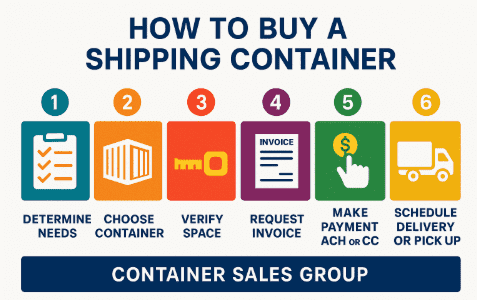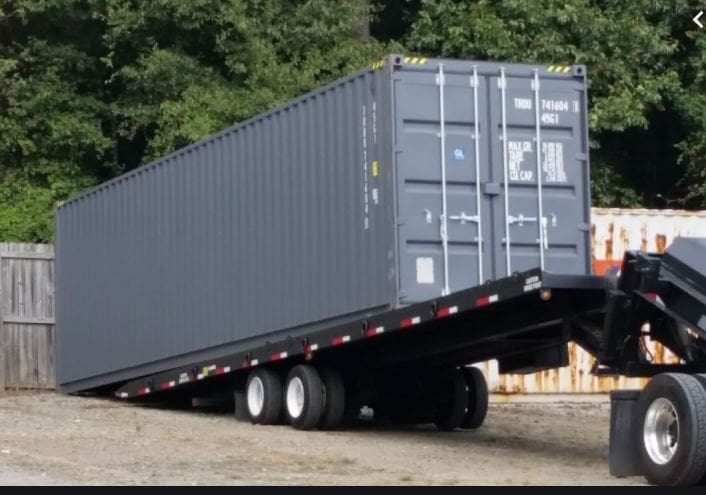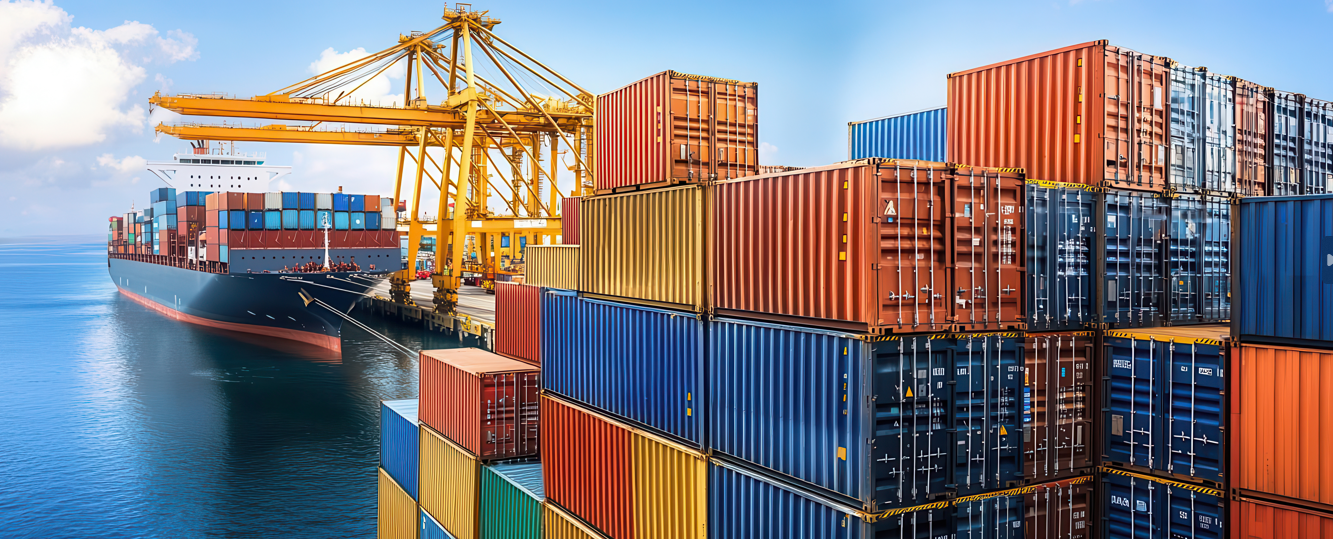Buying a shipping container is a big decision and getting it right means knowing more than just the price. Whether you’re purchasing for secure storage, a construction project or export shipping, understanding the process helps you make a smart, long-term investment.
At Container Sales Group, we’ve helped customers nationwide buy new and used shipping containers since 1998. As a women-owned company, we make it easy to find the right container, size, and condition — backed by our Wind & Water Tight Guarantee and transparent pricing.

Step 1: Determine Your Needs
Start with how you plan to use your container — that determines the right type, size, and condition.
Common uses include:
- On-site storage: Secure tools, equipment, or supplies at construction sites or facilities.
- Building projects: Convert into offices, workshops, pop-up shops, or tiny homes.
- Export shipping: Choose Cargo Worthy or New One-Trip containers that meet international standards.
Tip: Work with a reputable, nationwide supplier to avoid scams and get guaranteed quality.
Call 888-320-5938 for expert help choosing the right unit.
Working with a reputable dealer like Container Sales Group ensures you get a quality container, honest pricing, and expert support. CALL NOW FOR A QUOTE- 888 320-5938
Step 2: Choose the Right Shipping Container
Here’s a quick breakdown to help you decide:
When purchasing a shipping container, one of the first decisions you’ll make is whether to choose a New (one-trip) or Used container. Next, you’ll need to determine the right size based on your cargo volume or the space needed for a container conversion project. The two most common sizes for standard containers are 20ft and 40ft, and suppliers like Container Sales Group also offer 40ft. High Cube and 45ft. High Cube containers if you need extra vertical space.
Condition-
- New/One-Trip Containers
- These containers have only been used once to ship cargo from overseas.
- They’re in excellent condition with minimal wear, making them ideal if you’re planning to ship goods, modify the container (for a home, office, or retail use), or want it to look clean and professional.
- New/One-Trip Specialty Containers
- New containers are also available in specialty formats—like open-side, double-door, and high-cube models—great for unique applications that need more access or space.
- Used/Wind & Water-Tight Containers
- Used containers are more budget-friendly and still strong and secure.
- They may have some dents, surface rust, or signs of age but are great for general storage or construction projects.
- Most used containers are Wind & Watertight (WWT), which means they’re sealed from water and weather.
- Used Cargo Worthy Containers For Export
- If you’re planning to ship goods overseas using a used container, it must be Cargo Worthy (CW). This means it’s been inspected and certified to meet international shipping standards.
- New one-trip containers are automatically Cargo Worthy, but used containers need a formal inspection before export.
Common Shipping Container Sizes

20-Foot Standard Container
• Exterior Dimensions: 20 ft. long x 8 ft. wide x 8 ft. 6 in. high
• Approx. 1,170 cubic feet of storage space
• Great for smaller storage needs, job sites, or space-limited areas

40-Foot Standard Container
• Exterior Dimensions: 40 ft. long x 8 ft. wide x 8 ft. 6 in. high
• Approx. 2,390 cubic feet of storage space•Ideal for storing large equipment, inventory, or supplies

40-Foot High Cube Container
• Exterior Dimensions: 40 ft. long x 8 ft. wide x 9 ft. 6 in. high
• Approx. 2,700 cubic feet of storage space
• Offers extra height for tall items, shelving, or custom builds
If your cargo is unusually large, delicate, or requires easy access, a standard shipping container might not be the best fit. In these cases, specialty containers are designed to meet specific needs. Some of the most common types include:
- Open Top Containers replace a typical solid roof with a tarp. This still keeps freight protected and dry, but provides extra flexibility for top-loading and transporting oversized or abnormally shaped cargo such as timber.
- Open Side Containers also called “full access containers – allow quick and easy access to cargo through the larger opening. This makes them fantastic for long-term storage where you may not want to dig through every item to get to something in the back. They are also great for restaurant or bar conversions.
- Double Door Containers feature doors that open on each short end of the container, providing extra flexibility for loading and unloading cargo. They also provide flexibility to partition the space to transport two different types of freight in one container.
- Flat Rack Containers have only two short sides and no top, offering ultimate versatility for transporting items of all shapes and sizes. These shipping containers also make it easier to load and unload cargo.
Step 3: Verify Delivery Space & Prep the Ground for Delivery
It’s essential not only to verify the delivery space but also to choose an ideal location for your shipping container. The chosen site should have a solid, level surface that is well-drained—such as asphalt, gravel, or a concrete pad.
Level ground is especially crucial for a 40ft shipping container so that its doors can open and close properly. For additional support, you might consider placing railroad ties or wood blocks under each of the four corner posts. Typically, this setup is handled by two people at the time the container slides off the back of the truck during delivery.
It is important to make sure your site is ready for a safe and smooth delivery. Each delivery method requires a certain amount of clear, level space for drop-off. Taking the time to measure your site ahead of time can help avoid delays, extra fees, or complications on delivery day.
Types of Trucks Used For Shipping Container Delivery
Delivery Under 300 Miles– We will use a tilt-bed (roll-off) truck, which slides the container off the back.

Delivery Over 300 Miles– A flatbed truck is used. You’ll need equipment to offload the container.

Required Delivery Recommendations for Tilt-Bed (roll-off) Trucks
- 20ft shipping containers need 50ft of straight-line space
- 40ft shipping containers or 2 x 20 ft. shipping containers (moved together) need 150ft of straight-line space
- 12ft width clearance (no low-hanging wires or trees)
- 16ft height needed (at time of delivery when container slides off back of truck)
- Level, solid ground surface, gravel, asphalt, or cement
Check Permit Requirements
Before purchasing a shipping container, check if a permit is required in your area. Permit rules can vary widely by city, county, and state, especially for residential or commercial use.
Here’s what to keep in mind:
- Contact your local zoning or building department to ask about shipping container placement.
- Some areas may require a site plan, inspection, or fee before approval.
- Permit requirements often depend on how the container will be used (e.g., storage, office, living space).
- Failing to get the proper permit could result in fines, removal orders, or project delays.
Always verify requirements before delivery to avoid unexpected issues.
Step 4: Requesting a Quote and Invoice from Container Sales Group
Call Container Sales Group at 888-320-5938 or request a quote. Your quote will include the full container cost and delivery fee (if needed) based on your location.
We offer transparent pricing with no hidden fees—so you know exactly what to expect before placing your order.
To place your order, we’ll need:
- Your Name & Company Name
- Delivery address & Billing Address
- Delivery Contacts
- Door Direction Preference: Container facing Rear of truck (container doors slides off first) or facing Cab of truck (container doors slides off last)
Step 5: Make Payment
We offer multiple secure payment options. Payment can be via Credit Card, ACH or Check.
Once your payment is complete, our team will help you schedule the shipping container delivery or provide you with the information needed for container pick-up at a local depot.
Step 6: Schedule Your Shipping Container Delivery or Pick-Up
- Local shipping container delivery (within 100 miles): A tilt-body (roll-off) truck will typically deliver your container within 3–7 business days.
- Long-distance container delivery (over 100 miles): A flatbed truck is used. You’ll need to have equipment on-site such as a forklift or crane to unload the container upon arrival. Delivery may take up to 4 weeks depending on your location.
- Container pick-up at depot: You’ll receive a release number after payment, which authorizes your carrier to pick-up your shipping container from the depot.
Container Sales Group | Quality Container Guarantee
At Container Sales Group, every shipping container we sell—whether New/One-Trip, Used, or Cargo Worthy—comes backed by our Quality Container Guarantee. Each unit is thoroughly inspected by experienced professionals at our depot facilities to ensure it meets our high standards for structural integrity and functionality.
As part of our commitment to honesty and transparency, we ask that customers inspect the container alongside the driver at the time of delivery to confirm its condition matches the description provided.
If any issue arises that falls under our Quality Container Guarantee, we’ll address it promptly and professionally. We stand behind every container with honest pricing, reliable service, and a guarantee you can trust.
How To Inspect A Shipping Container
Inspecting a shipping container before delivery is essential to ensure you’re getting a unit that meets your needs and expectations. Whether you’re using it for storage, export, or a custom build, a thorough inspection helps you avoid hidden damage, costly repairs, or functionality issues down the line. Here’s what to look for when inspecting a new or used shipping container.
Condition: What to Expect
New Cargo Containers (One-Trip Containers)
These may have minor dings, scratches, or dents from handling during their one-time trip overseas. Despite this, they are in excellent condition and ideal for those who need a clean, like-new unit.
Used Cargo Containers
After 10 to 15 years of transporting freight across oceans and through various climates, used cargo containers will likely show signs of wear—such as surface rust, dents, or welded patches from professional repairs. This is completely normal and part of their service history.
Exterior Cargo Container Inspection
- Sidewalls
- Check that the Corten steel walls are structurally sound. Surface rust is typical, but there should be no rust holes
- Doors & Seals
- Doors are critical. They should open and close smoothly. If they’re hard to operate, make sure your container is on level ground—an uneven base can twist the structure and affect door alignment.
- Hinges and Locking Bars
- Test all hinges and locks to ensure they move freely. Apply lubricant after inspection to maintain smooth operation.
- Door Seals and Gaskets
- Inspect cracks or missing rubber gaskets. These seals prevent moisture, dirt, and pests from entering the cargo container.
- Corner Castings
- These reinforced corner fittings are vital for lifting, stacking, and securing the container. Make sure they’re intact and undamaged.
- Gaps and Door Alignment
- When the doors are closed, check for gaps or warping. You shouldn’t see daylight or feel drafts coming through the sealed door edges.
- Roof
- Climb safely or use a ladder to inspect the roof for dents or depressions where water can collect, which may lead to long-term rust issues.
Interior Cargo Container Inspection
- Doors
- Open and close doors to ensure they close and lock.
- Check that the locking rods, hinges, and handles are functional and not damaged.
- Examine the rubber gaskets for cracks, and stand inside the container to see if any daylight comes through the door seals, which could indicate potential leaks.
- Flooring
- Check for soft spots or loose panels that could affect safety or usability.
- Most cargo containers have a marine-grade plywood floor made of 19–21 layers (plies). It is mounted over welded steel crossmembers, spaced roughly 12–16 inches apart. Some wear or delamination (layer separation) is acceptable. Delamination should not affect multiple layers or structural integrity.
- Crossmember Bars
- Made of corrosion-resistant steel, the crossmembers underneath the floor are designed to support heavy loads. Make sure there is no rust-through or major deformation.
Smart Ways to Save on Shipping Containers
Looking to get the best possible deal on a shipping container? Follow these tips to learn how to buy shipping containers as cost-effectively as possible:
- Buy Direct from a Reputable Supplier – Skip the middleman and purchase from a trusted dealer like Container Sales Group for transparent, wholesale pricing.
- Choose Used or Cargo Worthy Containers – These offer solid performance at a lower cost than brand-new units.
- Consider Local Inventory – Buying from nearby depots can reduce or eliminate delivery fees.
- Ask About Specials or Bulk Discounts – Some suppliers like Container Sales Group offer discounts for multiple units or seasonal promotions.
- Avoid Scams – If a deal seems too good to be true, it probably is. Always check recent Google Reviews.
- Pick Up the Container Yourself – If you have the right equipment or access to a hauler, arranging your own pickup can often lower the total cost.
Your Reliable Source for Quality Shipping Containers Since 1998
Since 1998, Container Sales Group has been committed to providing New, Used, and Specialty Shipping Containers across the United States. We take pride in offering honest pricing, fast response times, and exceptional customer service, ensuring our customers receive high-quality conex boxes at direct, wholesale prices.
Call us today at 888-320-5938 or request a quote to get started!
